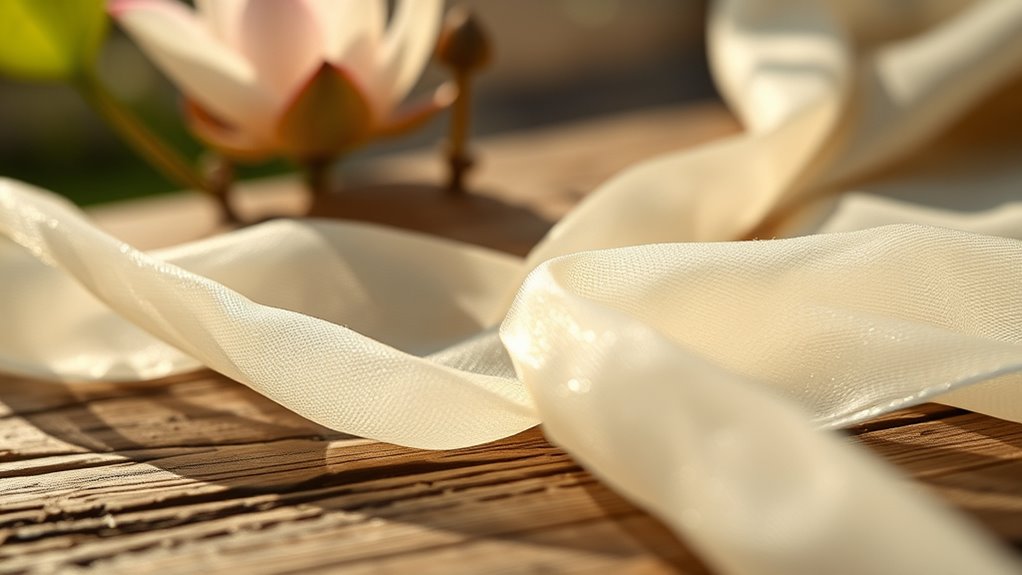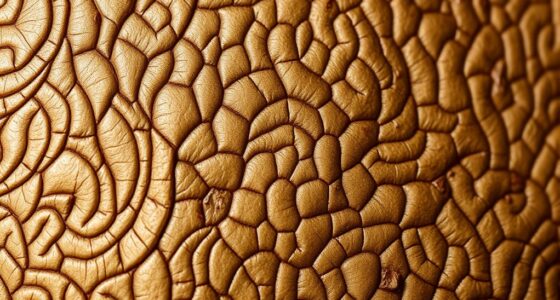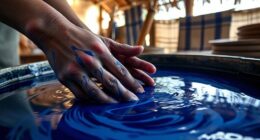Lotus silk is a rare, eco-friendly fabric made from fibers inside lotus seed pods, combining tradition with sustainability. You harvest the fibers carefully from mature lotus flowers without harsh chemicals or intensive farming, supporting ecological balance. This craft symbolizes purity and spiritual growth in many Asian cultures, connecting you to centuries-old techniques that respect nature. If you want to uncover more about its cultural significance and sustainable practices, keep exploring this extraordinary textile.
Key Takeaways
- Lotus silk is made from fibers inside lotus seed pods using traditional, sustainable harvesting techniques.
- The extraction process is eco-friendly, involving careful peeling and hand-spinning without chemicals.
- It symbolizes purity and cultural heritage in Asian traditions, representing patience and respect for nature.
- Harvesting supports ecological balance, ensuring lotus plants’ longevity and promoting environmentally conscious practices.
- Lotus silk embodies a connection between craftsmanship, sustainability, and cultural preservation for future generations.

Have you ever heard of a textile created from the delicate fibers of the lotus plant? If not, you’re about to discover a fascinating blend of tradition, sustainability, and craftsmanship. Lotus silk is produced from the fibers inside the seed pods of the lotus flower, a plant that holds deep cultural significance in many Asian cultures. When you explore how this unique fabric is made, you’ll see that traditional harvesting techniques play a crucial role in preserving its cultural roots as well as its ecological benefits.
Harvesting techniques for lotus silk are meticulous and respectful of the plant’s natural cycle. Typically, harvesters carefully cut the seed pods from mature lotus flowers, usually during the late summer or early autumn. Once the seed pods are collected, the delicate fibers are extracted by gently peeling away the outer layers without damaging the plant. This process requires patience and skill, as the fibers are incredibly fine and fragile. The fibers are then cleaned and spun into threads, often by hand, which highlights the craftsmanship involved. Unlike synthetic alternatives, lotus silk harvesting doesn’t involve harsh chemicals or intensive farming practices, making it an environmentally friendly choice. Moreover, the process of extracting fibers aligns with sustainable harvesting practices that ensure the longevity of the lotus plants.
Harvesting lotus silk involves gentle, skillful removal of seed pods without damaging the plant.
The cultural significance of lotus silk runs deep, especially in countries like India and China, where the lotus has been revered for centuries. The plant symbolizes purity, enlightenment, and rebirth, which adds layers of meaning to the fabric itself. Wearing lotus silk connects you to a tradition that values harmony with nature and spiritual growth. In many communities, the craft of creating lotus silk has been passed down through generations, often as a sacred art that embodies patience, precision, and respect for the environment. This cultural heritage elevates lotus silk beyond just a fabric; it becomes a symbol of identity, history, and sustainable living.
The process of harvesting and producing lotus silk isn’t hurried or industrialized; it’s rooted in cultural practices that honor the plant and its significance. When you wear or admire lotus silk, you’re engaging with a textile that embodies centuries of tradition, a deep respect for nature, and a commitment to sustainable craftsmanship. The delicate fibers extracted through careful, respectful harvesting techniques serve as a tribute to the harmony between humans and the environment. This sustainable approach ensures that the lotus plant continues to thrive and that the cultural stories it holds are preserved for future generations. In a world increasingly focused on eco-conscious choices, lotus silk offers a meaningful way to reconnect with tradition while supporting sustainable practices.
Frequently Asked Questions
How Long Does Lotus Silk Take to Produce?
The production duration of lotus silk varies, but it typically takes several months from harvesting to finished fabric. During the harvesting process, you carefully collect lotus stems, ensuring sustainability. The production process is time-consuming because the silk fibers are extracted by hand and require meticulous attention. Overall, this slow process emphasizes quality over speed, making lotus silk a unique, eco-friendly textile that reflects dedication and patience.
Is Lotus Silk Suitable for All Clothing Types?
Think of lotus silk as a gentle river flowing with versatility. It’s suitable for all clothing types, especially in winter, where its insulating properties keep you cozy. Its natural stretchability offers comfort, making it ideal for everything from elegant dresses to layered sweaters. You might find it effortlessly adaptable, wrapping you in softness while adding a touch of nature’s elegance to your wardrobe.
What Are the Environmental Benefits of Lotus Silk?
You’ll find that lotus silk offers significant environmental benefits. It’s biodegradable, meaning it naturally breaks down without harming the environment. Additionally, cultivating lotus plants requires minimal water, helping conserve water resources. By choosing lotus silk, you support sustainable practices that reduce pollution and water usage. This eco-friendly textile aligns with efforts to protect the planet, making it a responsible choice for environmentally conscious consumers seeking luxury without ecological harm.
Can Lotus Silk Be Dyed in Vibrant Colors?
Yes, you can dye lotus silk in vibrant colors using natural dyeing methods. Natural dyes derived from plants, minerals, or insects help achieve rich, vivid hues while maintaining eco-friendliness. To guarantee your colors stay bright over time, focus on achieving good colorfastness through proper mordanting techniques. With patience and care, you’ll enjoy beautifully dyed lotus silk that’s both stunning and sustainable, perfect for eco-conscious fashion and textiles.
How Does Lotus Silk Compare in Cost to Traditional Textiles?
Imagine walking into a garden where rare flowers bloom—lotus silk tends to be more expensive than traditional textiles. Its cost comparison reveals higher prices due to labor-intensive harvesting and limited supply. An affordability analysis shows it’s less accessible for everyday use but offers unique sustainability benefits. You might pay a premium, but you gain an exquisite, eco-friendly fabric that stands apart from mass-produced options, making it a luxurious choice for conscious consumers.
Conclusion
Imagine this: just one kilogram of lotus silk requires the fibers of around 2,000 lotus flowers, showcasing its incredible sustainability. By choosing this unique fabric, you’re supporting eco-friendly practices that conserve water and protect ecosystems. As you embrace lotus silk, you become part of a movement that values tradition and innovation. It’s a beautiful way to wear your values, knowing you’re helping to preserve our planet’s delicate balance—one stunning, sustainable thread at a time.









